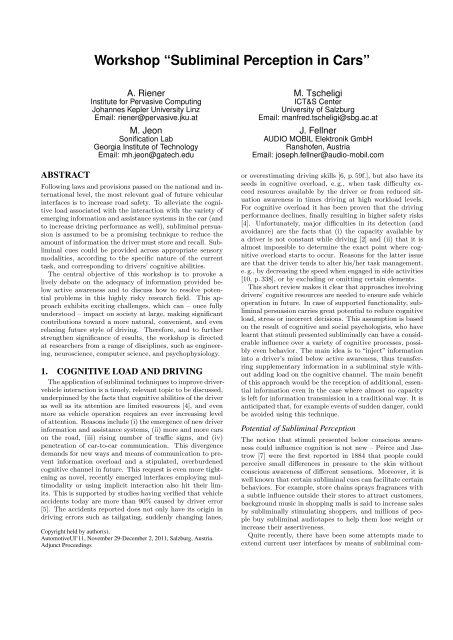Automotive User Interfaces and Interactive Vehicular Applications
Automotive User Interfaces and Interactive Vehicular Applications
Automotive User Interfaces and Interactive Vehicular Applications
You also want an ePaper? Increase the reach of your titles
YUMPU automatically turns print PDFs into web optimized ePapers that Google loves.
ABSTRACT<br />
Workshop “Subliminal Perception in Cars”<br />
A. Riener<br />
Institute for Pervasive Computing<br />
Johannes Kepler University Linz<br />
Email: riener@pervasive.jku.at<br />
M. Jeon<br />
Sonification Lab<br />
Georgia Institute of Technology<br />
Email: mh.jeon@gatech.edu<br />
Following laws <strong>and</strong> provisions passed on the national <strong>and</strong> international<br />
level, the most relevant goal of future vehicular<br />
interfaces is to increase road safety. To alleviate the cognitive<br />
load associated with the interaction with the variety of<br />
emerging information <strong>and</strong> assistance systems in the car (<strong>and</strong><br />
to increase driving performance as well), subliminal persuasion<br />
is assumed to be a promising technique to reduce the<br />
amount of information the driver must store <strong>and</strong> recall. Subliminal<br />
cues could be provided across appropriate sensory<br />
modalities, according to the specific nature of the current<br />
task, <strong>and</strong> corresponding to drivers’ cognitive abilities.<br />
The central objective of this workshop is to provoke a<br />
lively debate on the adequacy of information provided below<br />
active awareness <strong>and</strong> to discuss how to resolve potential<br />
problems in this highly risky research field. This approach<br />
exhibits exciting challenges, which can – once fully<br />
understood – impact on society at large, making significant<br />
contributions toward a more natural, convenient, <strong>and</strong> even<br />
relaxing future style of driving. Therefore, <strong>and</strong> to further<br />
strengthen significance of results, the workshop is directed<br />
at researchers from a range of disciplines, such as engineering,<br />
neuroscience, computer science, <strong>and</strong> psychophysiology.<br />
1. COGNITIVE LOAD AND DRIVING<br />
The application of subliminal techniques to improve drivervehicle<br />
interaction is a timely, relevant topic to be discussed,<br />
underpinned by the facts that cognitive abilities of the driver<br />
as well as its attention are limited resources [4], <strong>and</strong> even<br />
more as vehicle operation requires an ever increasing level<br />
of attention. Reasons include (i) the emergence of new driver<br />
information <strong>and</strong> assistance systems, (ii) more <strong>and</strong> more cars<br />
on the road, (iii) rising number of traffic signs, <strong>and</strong> (iv)<br />
penetration of car-to-car communication. This divergence<br />
dem<strong>and</strong>s for new ways <strong>and</strong> means of communication to prevent<br />
information overload <strong>and</strong> a stipulated, overburdened<br />
cognitive channel in future. This request is even more tightening<br />
as novel, recently emerged interfaces employing multimodality<br />
or using implicit interaction also hit their limits.<br />
This is supported by studies having verified that vehicle<br />
accidents today are more than 90% caused by driver error<br />
[5]. The accidents reported does not only have its origin in<br />
driving errors such as tailgating, suddenly changing lanes,<br />
Copyright held by author(s).<br />
<strong>Automotive</strong>UI’11, November 29-December 2, 2011, Salzburg, Austria.<br />
Adjunct Proceedings<br />
M. Tscheligi<br />
ICT&S Center<br />
University of Salzburg<br />
Email: manfred.tscheligi@sbg.ac.at<br />
J. Fellner<br />
AUDIO MOBIL Elektronik GmbH<br />
Ranshofen, Austria<br />
Email: joseph.fellner@audio-mobil.com<br />
or overestimating driving skills [6, p. 59f.], but also have its<br />
seeds in cognitive overload, e. g., when task difficulty exceed<br />
resources available by the driver or from reduced situation<br />
awareness in times driving at high workload levels.<br />
For cognitive overload it has been proven that the driving<br />
performance declines, finally resulting in higher safety risks<br />
[4]. Unfortunately, major difficulties in its detection (<strong>and</strong><br />
avoidance) are the facts that (i) the capacity available by<br />
a driver is not constant while driving [2] <strong>and</strong> (ii) that it is<br />
almost impossible to determine the exact point where cognitive<br />
overload starts to occur. Reasons for the latter issue<br />
are that the driver tends to alter his/her task management,<br />
e. g., by decreasing the speed when engaged in side activities<br />
[10, p. 338], or by excluding or omitting certain elements.<br />
This short review makes it clear that approaches involving<br />
drivers’ cognitive resources are needed to ensure safe vehicle<br />
operation in future. In case of supported functionality, subliminal<br />
persuasion carries great potential to reduce cognitive<br />
load, stress or incorrect decisions. This assumption is based<br />
on the result of cognitive <strong>and</strong> social psychologists, who have<br />
learnt that stimuli presented subliminally can have a considerable<br />
influence over a variety of cognitive processes, possibly<br />
even behavior. The main idea is to “inject” information<br />
into a driver’s mind below active awareness, thus transferring<br />
supplementary information in a subliminal style without<br />
adding load on the cognitive channel. The main benefit<br />
of this approach would be the reception of additional, essential<br />
information even in the case where almost no capacity<br />
is left for information transmission in a traditional way. It is<br />
anticipated that, for example events of sudden danger, could<br />
be avoided using this technique.<br />
Potential of Subliminal Perception<br />
The notion that stimuli presented below conscious awareness<br />
could influence cognition is not new – Peirce <strong>and</strong> Jastrow<br />
[7] were the first reported in 1884 that people could<br />
perceive small differences in pressure to the skin without<br />
conscious awareness of different sensations. Moreover, it is<br />
well known that certain subliminal cues can facilitate certain<br />
behaviors. For example, store chains sprays fragrances with<br />
a subtle influence outside their stores to attract customers,<br />
background music in shopping malls is said to increase sales<br />
by subliminally stimulating shoppers, <strong>and</strong> millions of people<br />
buy subliminal audiotapes to help them lose weight or<br />
increase their assertiveness.<br />
Quite recently, there have been some attempts made to<br />
extend current user interfaces by means of subliminal com-





